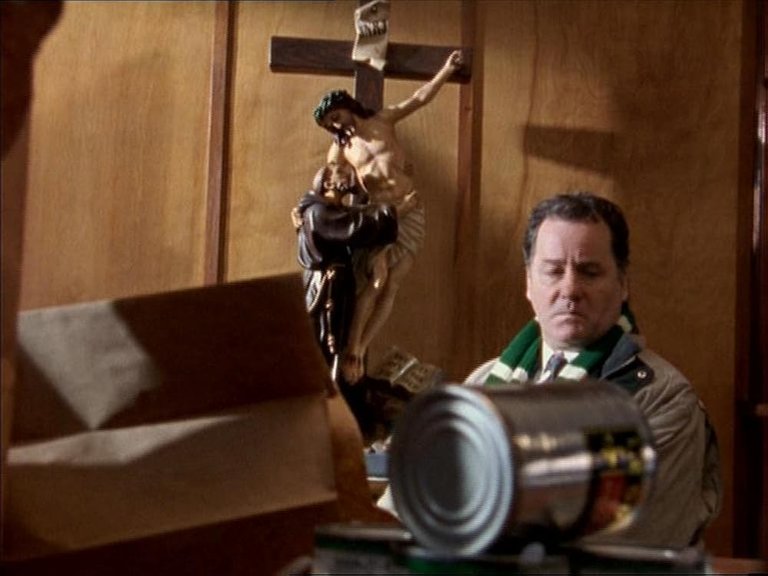Television Review: Something Sacred: Part I (Homicide: Life on the Street, S6X12, 1998)

Something Sacred: Part I (S06E12)
Airdate: 30 January 1998
Written by: Anya Epstein
Directed by: Uli Edel
Running Time: 45 minutes
The final two seasons of Homicide: Life on the Street offered audiences a steady diet of high-stakes, sensational cases—the so-called “redballs”. These episodes, particularly the multi-part installments, often leaned into media-fuelled scandals, political pressure, and morally complex scenarios. Yet even by those standards, Something Sacred: Part I, the first half of Season 6’s two-part episode, delivers a case that surpasses its predecessors in sheer scale and societal weight. The murder of a revered Catholic priest, coupled with the looming spectre of clergy abuse and the precarious lives of Central American refugees, sets the stage for a narrative that is both gripping and emblematic of the era’s unresolved tensions. This episode thrives on its audacious premise but stumbles under the weight of its own ambition, its side plots, and a cliffhanger that prioritises shock value over narrative cohesion.
The central case revolves around the killing of Father Michael Juneaux, a 51-year-old priest whose humanitarian work with Central American refugees had made him a local hero. Juneaux’s murder immediately escalates into a media frenzy, as Lt. Giardello notes: no priest had been killed in decades in a city where the Catholic Church holds immense cultural and political sway. Detectives Stuart Gharty and Laura Ballard are assigned to the case, and their investigation quickly zeroes in on Luis Caranza (Michael Peña) and Pedro Velez (Victor Anthony), two Guatemalan teenagers staying at Juneaux’s rectory who vanish after the murder. The duo’s desperation to avoid deportation to a war-torn homeland initially seems like the most plausible motive for their avoidance of police, but their story is complicated by the intervention of Swami Prabhunanda (Rozwill Young), a flamboyant leader of a syncretic cult who claims Juneaux engaged in inappropriate relationships with young men. Though the detectives dismiss these allegations as fringe conspiracy-mongering, the episode ends with a second murder—the slaying of Monsignor Jaeger, the bishop—leaving the suspects’ guilt unresolved and their fate uncertain.
The episode’s exploration of the Catholic Church’s complicity in covering up sexual abuse—both fictional and real—marks its most daring achievement. Long before the 2002 Boston Globe exposé shattered the scandal’s silence, Homicide here treads carefully into taboo territory. While the show stops short of confirming whether Juneaux abused the boys, the mere suggestion of misconduct looms large, framed through the prism of real-world cases Pembleton references. The tension between institutional authority and moral corruption is palpable, as the Church’s political clout stifles scrutiny while activists like Dyanne Attwood (Leslie Silva), a Catholic nun turned lawyer, weaponise public sentiment to protect the suspects. This dynamic mirrors the real-world dilemma of balancing victims’ rights with institutional reputation—a conversation still unresolved in 1998, when the episode aired. The show’s refusal to deliver easy answers underscores its commitment to ambiguity, though the unresolved allegations leave the narrative feeling incomplete, as if the writers feared going too far.
The plight of Central American refugees, meanwhile, is handled with empathy but little overt advocacy. Luis and Pedro’s fear of returning to Guatemala—a nation ravaged by Cold War-era violence—is conveyed through raw performances, particularly Michael Peña’s harrowing portrayal of a young man clinging to hope. Yet the episode avoids overt political messaging, instead letting the characters’ despair speak for itself. This restraint, while admirable in its refusal to preach, leaves the issue underexplored. The writers sidestep the complexities of immigration policy, focusing instead on the boys’ personal trauma, which feels both respectful and frustratingly narrow. Their release by detectives—prompted by activist pressure—hints at systemic failures but sidesteps accountability, leaving the audience to grapple with moral ambiguity without clear resolution.
The partnership between Detectives Ballard and Gharty emerges as a subtle triumph. The dynamic between the progressive Ballard and the brash, conservative Gharty—a standout performance by Peter Gerety—adds depth to the procedural elements. Gharty’s traditional values, rooted in his blue-collar background and youthful aspirations to priesthood, clash with Ballard’s scepticism, creating a compelling interplay of faith and doubt. Their exchanges, particularly Gharty’s discomfort with the Swami’s allegations, reveal how personal beliefs can both inform and hinder police work. Meanwhile, Pembleton’s exchanges with Ballard about faith underscore the show’s broader theme of spirituality as a double-edged sword, offering solace but also complicating moral judgment. These character moments elevate the episode beyond mere plot mechanics.
Yet Something Sacred: Part I falters in its execution of secondary threads. Director Uli Edel, a series veteran, handles the primary narrative with his customary crispness, but the side plots feel perfunctory. The subplot involving Detective Stivers replacing the suspended Lewis as part of the team is shoehorned in, clashing with Kellerman’s lingering resentment over the Luther Mahoney shooting—a prior storyline that still hangs unresolved. Similarly, Falsone’s custody battle with his ex-wife devolves into clichés about family dysfunction, offering little more than a distraction from the main case. These undercooked subplots betray the episode’s ambition, as if the writers felt obligated to maintain the show’s ensemble tradition even when it dilutes focus.
Ultimately, Something Sacred: Part I is a compelling but imperfect entry in Homicide’s canon. It tackles bold themes—clerical abuse, immigration, and institutional power—with intelligence and nuance, though its reluctance to confront these issues head-on leaves it feeling half-finished. The cliffhanger, introducing the murder of a bishop, hints at a Part II that could either elevate or derail the narrative. Yet the decision to escalate the stakes to such a high-profile victim—another “redball” trope—suggests the show prioritising ratings over its signature grit. While the episode’s flaws are evident, its willingness to engage with uncomfortable truths and its layered character work ensure it remains a standout example of the series’ ambition in its final act.
RATING: 6/10 (++)
Blog in Croatian https://draxblog.com
Blog in English https://draxreview.wordpress.com/
InLeo blog https://inleo.io/@drax.leo
Hiveonboard: https://hiveonboard.com?ref=drax
Rising Star game: https://www.risingstargame.com?referrer=drax
1Inch: https://1inch.exchange/#/r/0x83823d8CCB74F828148258BB4457642124b1328e
BTC donations: 1EWxiMiP6iiG9rger3NuUSd6HByaxQWafG
ETH donations: 0xB305F144323b99e6f8b1d66f5D7DE78B498C32A7
BCH donations: qpvxw0jax79lhmvlgcldkzpqanf03r9cjv8y6gtmk9